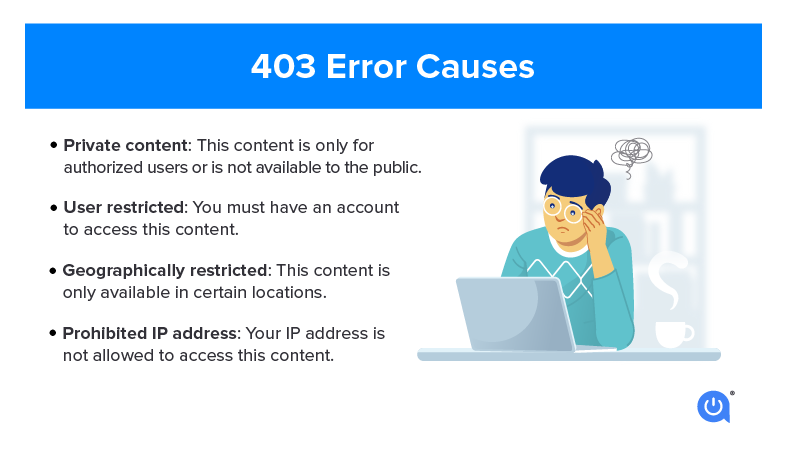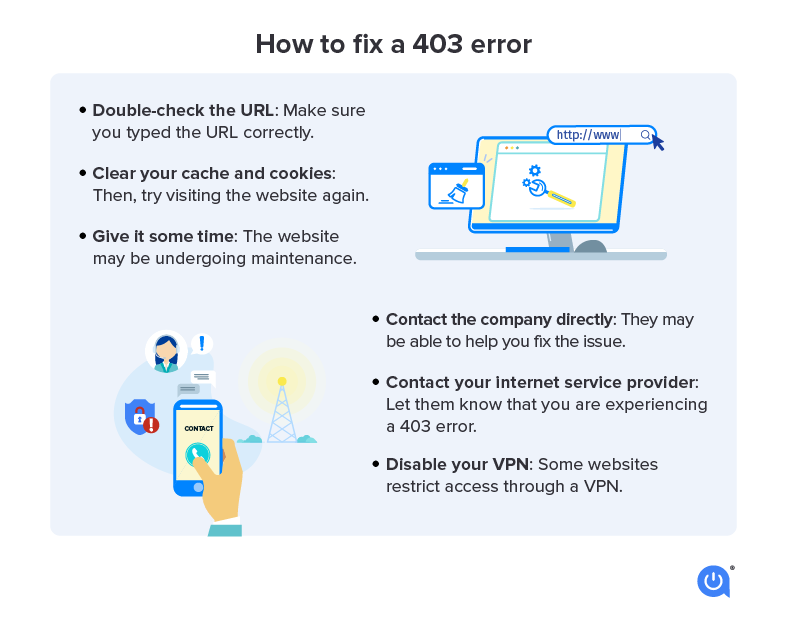While it may seem intimidating initially, a 403 forbidden error message is easier to resolve than you might think. The 403 error simply means that, for some predetermined reason, the website’s content you’re trying to access is being blocked. The reason might be within your control – but it’s more likely caused by something on the content owner or server side. The good news is there are a few quick and easy ways to fix an HTTP 403 error message.
What is a 403 forbidden error?
A 403 forbidden error is an HTTP status code that means “access denied.”
If you ever had a treehouse as a kid, you may have posted a sign above the door that said, “keep out.” Essentially, that’s what an HTTP 403 Forbidden message is. You may also see it appear as:
- 403 forbidden
- 403 error
- 403 forbidden access
- HTTP 403
- Status code 403
- Access denied
Before we jump into how to solve the issue, let’s explore why you’re getting the message in the first place.
Reasons why you might get a 403 error
There are several possibilities as to why you’re seeing a status code 403:

- The content is private – The content owner has designated it as private. The reason? It could be anything from temporary, behind-the-scenes website updates to the website being subscriber-only access.
- User restricted – Only authenticated users can access the content. This comes into play with organizations such as libraries and schools, which might have a limited number of content users.
- Geographically restricted – Some sites only allow you access if you live in a specific geographic location. Examples of this are Netflix and Hulu. How does the website know where you’re located? Your IP address is unique to your computer and acts like a street address.
- Prohibited IP address – There can be several reasons for this, but sometimes it boils down to spam or unwanted posts from a specific IP address. It can also be as simple as too many failed login attempts.
6 ways to fix a 403 forbidden error
Take a few minutes to troubleshoot a 403 error. These suggested techniques aren’t complicated or overly technical and worth the time. We suggest you try them in the order provided since you might fix the problem on the first attempt.

- Double-check the URL – It’s easy to mistype a URL, so simply retyping may fix the 403 error.
- Clear your cache and cookies – You’ve likely heard the terms cache and cookies, but you should know that they play specific and different roles. Think of a cookie as leaving crumbs or tiny bits of information about where you’ve been on a site, what you like on the site, etc. The cache is more about speed since its purpose is to make loading time faster. An added benefit to clearing cache is that it may also improve your overall internet speed.
- Give it some time – Visit other sites, get a cup of coffee or go for a walk. Allowing some time to go by may reveal that the 403 error was nothing more than in-progress website updates. Those updates are generally made as quickly as possible to minimize disruption.
- Contact the company, service or organization directly – It could be that the 403 error is ongoing and multiple people are experiencing it. You may need to reach out and let someone know about the issue.
- Contact your internet service provider – Your IP address may be blocked for some reason; however, this scenario is lower on our list because it doesn’t happen often. If you’ve ruled out all of the above suggestions, contact your internet service provider to get some insight on whether or not the site is blocked.
- Disable your VPN – If you use a VPN and get a 403 status code, try disabling it and reloading the page, as some sites restrict access through a VPN.
How to fix a 403 error code on your website
The steps above are similar to how to clear a 403 error on your own website. According to kinsta.com, there are a few simple things to try first, like refreshing your page and double-checking the address you typed in. Clearing your browser cache can also help clear a 403 error.
If you are a site owner throwing out 403 forbidden errors, there are ways to help eliminate those.
If those tricks don’t help, you’ll need to digger deeper with these recommendations by kinsta.com:
- Deactivate and then reactivate your plugins
- Modify your file permissions
- Temporarily deactivate CDN
- Check if hotlink protection is misconfigured
- Disconnect your VPN
If the 403 error persists, you’ll need to contact your hosting provider.
Common HTTP status code errors
Chances are, you’ve seen a 404 page not found error more often than a 403. 403s occur when your access to web content is denied. Double-checking your URL, disabling your VPN and clearing your cache are quick fixes, but you can also contact your ISP or the company directly to try and solve the issue. 500 internal error codes can signal a problem with the server of the site you are trying to reach.
HTTP error FAQs
The first thing to try to fix a 403 forbidden error message is to clear your cache and cookies and disconnect from a VPN if you’re using one just to make sure it’s not an issue on your end. If the problem persists, you may need to contact your ISP or the site’s administrator.
It sounds foreboding, but it simply means the website’s content is blocked for some reason.
When you see a 403 forbidden error on a site you’re trying to load, it means that you don’t have permission to view it. It’s not necessarily an issue on your end, but a problem with the permissions on the site itself.
Explore the rest of the Resource Center to learn more about common internet errors and what you can do about them.

Written by:
Camryn Smith
Cammy is a writer with Allconnect, growing her broadband industry knowledge for over a year on the internet marketplace. Her expertise lies in home internet and broadband service with a focus on providers, plans…
Read more
Edited by:
Robin LaytonEditor, Broadband Content
-
Featured
![Learn how to manage your internet browser history]() Learn how to manage your internet browser history Robin Layton — 4 min read
Learn how to manage your internet browser history Robin Layton — 4 min read -
Featured
![What a 404 ‘page not found’ error is and ways to fix it]() What a 404 ‘page not found’ error is and ways to fix it Alex Sheehan — 3 min read
What a 404 ‘page not found’ error is and ways to fix it Alex Sheehan — 3 min read -
Featured
![502 bad gateway error: What it is and how to fix it]() 502 bad gateway error: What it is and how to fix it Camryn Smith — 3 min read
502 bad gateway error: What it is and how to fix it Camryn Smith — 3 min read
Latest
-
Friday, April 19, 2024
Can other Wi-Fi networks interfere with mine?Robin Layton — 4 min read
-
Thursday, April 18, 2024
Comcast introduces new pre-paid internet, mobile and streaming plansRobin Layton — 2 min read
-
Thursday, April 18, 2024
T-Mobile imposes data cap of 1.2TB/mo.Robin Layton — 2 min read






